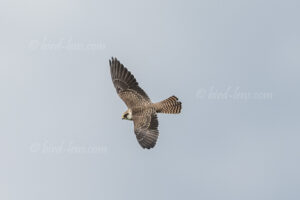 It’s migration time again. Six Common Snipes (Gallinago gallinago) fly up from the wetland in the middle of the agricultural steppe. The reason seems unclear to me until I see 2 small raptors circling over the area. A raptor, the one with a gray upperside, looks like a sparrowhawk; not much larger or the same size as the following raptor, which is clearly a falcon. But somehow the first raptor seems different. In addition, he is not just accompanied by the following raptor, but is obviously being chased or attacked. A look through the binoculars confirms the assumption. An individual of the Red-footed Falcon (Falco vespertinus) flies in a circle together with a Common Kestrel (Falco tinnunculus). The Kestrel then disappeared, but the Red-footed Falcon leisurely circles around and is nice to admire.
It’s migration time again. Six Common Snipes (Gallinago gallinago) fly up from the wetland in the middle of the agricultural steppe. The reason seems unclear to me until I see 2 small raptors circling over the area. A raptor, the one with a gray upperside, looks like a sparrowhawk; not much larger or the same size as the following raptor, which is clearly a falcon. But somehow the first raptor seems different. In addition, he is not just accompanied by the following raptor, but is obviously being chased or attacked. A look through the binoculars confirms the assumption. An individual of the Red-footed Falcon (Falco vespertinus) flies in a circle together with a Common Kestrel (Falco tinnunculus). The Kestrel then disappeared, but the Red-footed Falcon leisurely circles around and is nice to admire.
It takes about half an hour until the first Snipes flutter back in and then stand quietly, relying on the camouflage of their plumage, between dead grass and willow branches. A little later, more individuals arrive. Finally, 6 Snipes are hanging around in front of the hide again. If the comfort distance is not reached, there are always short pursuits.
The area was heavily flooded during heavy rain in the wet summer. Now the highest water levels have already receded, revealing muddy meadow areas that have good feeding grounds, which are important not only for the Snipes.
The gentle hilly landscape of the Niederer (Lower) Fläming is heavily influenced by agriculture. But 4 years ago I saw two very delicate birds sitting on the lines near a transformer station or a pumping station near Bochow, which could already be seen from a distance. I wondered if they were lovebirds? But a look through the spotting scope showed two one-year-old Red-footed Falcons
What is characteristic of the Red-footed Falcon is its graceful and agile flight behavior, which is generally placed between the Kestrel and the Hobby (Falco subbuteo), but can also have typical characteristics of both falcons. It has a fast and agile cross-country flight on retracted wings, often raising its fangs at the last moment to catch prey (i.e. like a Hobby); but he still hunts from a fixed position or shakes like a Kestrel. Red-footed Falcons fly with a fairly stiff, regular wing beat and can even resemble the Common Cuckoo (Cuculus canorus) in flight. This effect is reinforced by its comparatively long tail as well.
There is currently no particular influx of red-footed falcons to be observed. However, the focus remains primarily on the east and north of Germany.
To meet the growing demand for top-of-the-line images of the rarer Palaearctic species, Bird-lens.com strives to expand the range of images of Western Palaearctic birds. Trips to many locations to take pictures of rare western Palearctic birds have been very successful. This nice picture of the blog is just a first impression of what you can find in the gallery of the “Picture Shop” very soon. Please leave a message if bird-lens.com can provide a picture.